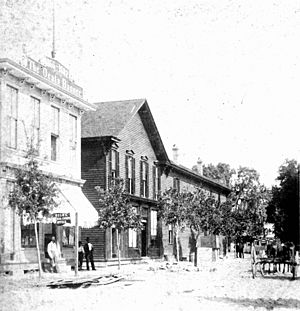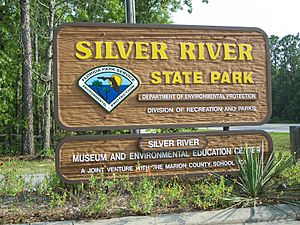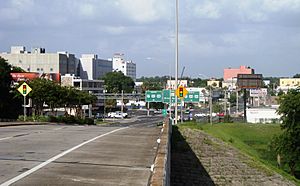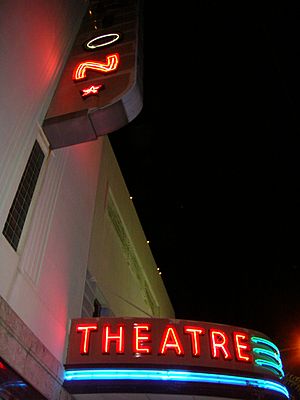Ocala, Florida facts for kids
Quick facts for kids
Ocala, Florida
|
||
|---|---|---|
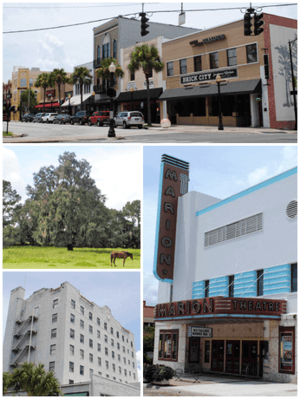
Top, left to right: Downtown Ocala, horse on a farm, Marion Hotel, Marion Theatre
|
||
|
||
| Nickname(s):
Horse Capital of the World
|
||
| Motto(s):
"God Be With Us"
|
||
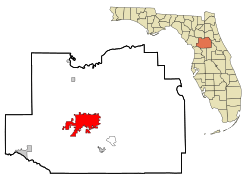
Location in Marion County and the state of Florida
|
||
| Country | United States | |
| State | Florida | |
| County | Marion | |
| Settled | 1849 | |
| Incorporated (town) | February 4, 1869 | |
| Incorporated (city) | January 28, 1885 | |
| Government | ||
| • Type | Council-manager | |
| Area | ||
| • City | 47.26 sq mi (122.41 km2) | |
| • Land | 47.26 sq mi (122.39 km2) | |
| • Water | 0.01 sq mi (0.01 km2) | |
| Elevation | 104 ft (32 m) | |
| Population
(2020)
|
||
| • City | 63,591 | |
| • Rank | US: 638th | |
| • Density | 1,345.64/sq mi (519.56/km2) | |
| • Urban | 156,909 (US: 211th) | |
| • Metro | 354,353 (US: 149th) | |
| Time zone | UTC−5 (Eastern (EST)) | |
| • Summer (DST) | UTC−4 (EDT) | |
| ZIP codes |
34470-34483
|
|
| Area code(s) | 352 | |
| FIPS code | 12-50750 | |
| GNIS feature ID | 0288030 | |
| Website | OcalaFL.org | |
Ocala ( oh-KAL-ə) is a city in and the county seat of Marion County within the northern region of Florida, United States. As of the 2020 United States Census, the city's population was 63,591, making it the 54th most populated city in Florida.
Home to over 400 thoroughbred farms and training centers, Ocala was officially named the Horse Capital of the World in 2007. Notable attractions include the Ocala National Forest, Silver Springs State Park, Rainbow Springs State Park, and the College of Central Florida.
Ocala is the principal city of the Ocala, Florida Metropolitan Statistical Area, which had an estimated 2017 population of 354,353.
Contents
History
Archeological investigation has revealed that the area was inhabited by varying cultures of indigenous peoples from as early as 6500 B.C., and there were two lengthy periods of occupation. The second lasted through 500 A.D. In early historic times, the Timucua inhabited the area.
Ocala is located near what is thought to have been the site of Ocale or Ocali, a major Timucua village and chiefdom recorded in the 16th century. The modern city takes its name from the historical village, the name of which is believed to mean "Big Hammock" in the Timucua language. The Spaniard Hernando de Soto's expedition recorded Ocale in 1539 during his exploration through what is today the southeastern United States. Ocale is not mentioned in later Spanish accounts; it appears to have been abandoned in the wake of de Soto's attack.
In the late eighteenth and early nineteenth centuries, Creek people and other Native Americans, and free and fugitive African Americans sought refuge in Florida. The Seminole people formed. After foreign colonial rule shifted between Spain and Great Britain and back again, in 1821 the United States acquired the territory of Florida. After warfare to the north, in 1827 the U.S. Army built Fort King near the present site of Ocala as a buffer between the Seminole, who had long occupied the area, and white settlers moving into the region. The fort was an important base during the Second Seminole War and later served in 1844 as the first courthouse for Marion County.
The modern city of Ocala, which was established in 1849, developed the city around the fort site. Greater Ocala is known as the "Kingdom of the Sun". Plantations and other agricultural development dependent on slave labor were prevalent in the region. Ocala was an important center of citrus production until the Great Freeze of 1894–1895.
Rail service reached Ocala in June 1881, encouraging economic development with greater access to markets for produce. Two years later, much of the Ocala downtown area was destroyed by fire on Thanksgiving Day, 1883. The city encouraged rebuilding with brick, granite and steel rather than lumber. By 1888, Ocala was known statewide as "The Brick City".
In December 1890, the Farmers' Alliance and Industrial Union, a forerunner of the Populist Party, held its national convention in Ocala. At the convention, the Alliance adopted a platform that would become known as the "Ocala Demands". This platform included abolition of national banks, promoting low-interest government loans, free and unlimited coinage of silver, reclamation of excess railroad lands by the government, a graduated income tax, and direct election of United States senators. Most of the "Ocala Demands" were to become part of the Populist Party platform.
20th-century establishment as horse capital
The first thoroughbred horse farm in Florida was developed in 1943 by Carl G. Rose, who had come to Florida in 1916 from Indiana to oversee construction of the first asphalt road in the state. When he ran into problems with asphalt, he improvised and experimented with limestone, an abundant resource in the state which he realized supported good pasture for raising strong horses (limestone nurtures Kentucky's Bluegrass Region, long a center of thoroughbred horse farms). In 1943, Rose bought land along State Highway 200, at $10 per acre, which became Rosemere Farm. The next year one of his horses, Gornil, won at Miami's Tropical Park, becoming the first Florida-raised thoroughbred to win a Florida race.
Close on Rose's heels, entrepreneur Bonnie Heath set up his own thoroughbred farm, producing the state's first winner of the Kentucky Derby. Highways were named in Ocala after each of these men. Bonnie Heath Farm is now owned and operated by Bonnie Heath III and his wife Kim. Rosemere Farm was sold long ago, the large site redeveloped with retail center Paddock Mall and the College of Central Florida.
In 1956, the Ocala-area Thoroughbred industry received a boost when Needles became the first Florida-bred to win the Kentucky Derby. In 1978, Marion County-bred-and-raised Affirmed won the Triple Crown. Today, Marion County is a major world thoroughbred center with over 1200 horse farms, including about 900 thoroughbred farms, totaling some 77,000 acres (310 km2). Ocala is well known as a "horse capital of the world."
Ocala is one of only five cities (four in the US and one in France) permitted under Chamber of Commerce guidelines to use this title, based on annual revenue produced by the horse industry. 44,000 jobs are sustained by breeding, training, and related support of the equine industry, which generates over $2.2 billion in annual revenue. "Postime Farms" and Ocala serve as host to one of the largest horse shows in the country: H.I.T.S or "Horses in the Sun", a Dressage/Jumper event lasting about two months which generates some 6 to 7 million dollars for local Marion County economy each year. The show features classes for over 100 different breeds, including Tennessee Walker, Paso Fino, Morgan horse, SaddleBred, Draft horse and the American Quarter Horse. Other equine events in the area include cowboy mounted shooting by the Florida Outlaws, as well as endurance rides, barrel races, "extreme" cowboy events, jumper shows, trick shows, parades, draft pulls, rodeo events and more.
Tourism
The nearby community of Silver Springs developed around the Silver Springs, a group of artesian springs on the Silver River. In the 19th century, this site became Florida's first tourist destination. Today well known for glass bottom boat tours of the area, Silver Springs is owned by the state of Florida and incorporated into Silver Springs State Park in 2013. Other nearby natural attractions include the Ocala National Forest and the Florida Trail. Manmade local attractions include Wild Waters water park; the western-themed Six Gun Territory operated in the area until 1984.
Growth
In the last decades of the twentieth century, the greater Ocala area had one of the highest growth rates in the country for a city its size. The population of Marion County in 2000 was more than 250,000, up from under 100,000 in 1975.
Ocala Historic District
Many historic homes are preserved in Ocala's large residential Historic District, designated in 1984. East Fort King Street features many excellent examples of Victorian architecture. Ocala structures listed on the National Register of Historic Places include the Coca Cola Building, the E. C. Smith House, East Hall, the Marion Hotel, Mount Zion A.M.E. Church, the Ritz Historic Inn, and Union Train Station.
The original Fort King site was designated as a National Historic Landmark in 2004.
Geography
Ocala is located at 29°11′16″N 82°07′50″W / 29.187704°N 82.130613°W.
According to the United States Census Bureau, the city has a total area of 38.63 square miles (100.1 km2), all land. The surrounding farms are famous for their thoroughbred horses, in terrain similar to Kentucky bluegrass. Ocala is also known for nearby Silver Springs, Florida, site of one of the largest artesian spring formations in the world and Silver Springs Nature Theme Park, one of the earliest tourist attractions in Florida.
The 110-mile (180 km) long Ocklawaha River flows north from Central Florida until it joins the St. Johns River near Palatka, Florida.
Marion County is also home to the Ocala National Forest which was established in 1908 and is now the second largest national forest in the state. The Florida Trail, also known as the Florida National Scenic Trail, cuts through Ocala National Forest. Silver Springs State Park was formed as Silver River State Park in 1987, out of land the state purchased around the Silver Springs attraction to spare it from development. The state took over Silver Springs itself in 1993 and incorporated it into the park in 2013.
Climate
Ocala has two distinct seasons: the dry season (October–May) and the wet season (June–September). During the dry season, there is almost uninterrupted sunshine with very little rainfall. In January, the morning low temperatures are often in the 30s and 40s, but the cloudless sunny weather typically warms the dry air up to near 70 by the afternoon. During the wet season, afternoon thunderstorms are a daily occurrence. These storms are often severe (unofficially, Ocala is known to have more cloud-to-ground lightning per square mile than any other city in the world). The typical morning low temperatures during the wet season are in the 70s and typical daytime high temperatures are in the 90s. Due to the city being relatively far away from the moderating influence of the Atlantic Ocean and the Gulf of Mexico, Ocala's summertime high temperatures are often the highest in the state while winter night temperatures are often the lowest compared to other cities on the peninsula.
| Climate data for Ocala, Florida (1981–2010 normals) | |||||||||||||
|---|---|---|---|---|---|---|---|---|---|---|---|---|---|
| Month | Jan | Feb | Mar | Apr | May | Jun | Jul | Aug | Sep | Oct | Nov | Dec | Year |
| Record high °F (°C) | 88 (31) |
90 (32) |
97 (36) |
98 (37) |
102 (39) |
105 (41) |
104 (40) |
103 (39) |
101 (38) |
98 (37) |
94 (34) |
90 (32) |
105 (41) |
| Average high °F (°C) | 71.3 (21.8) |
74.5 (23.6) |
78.9 (26.1) |
84.0 (28.9) |
89.8 (32.1) |
92.2 (33.4) |
93.2 (34.0) |
92.6 (33.7) |
90.5 (32.5) |
85.3 (29.6) |
78.6 (25.9) |
72.6 (22.6) |
83.6 (28.7) |
| Average low °F (°C) | 44.8 (7.1) |
47.5 (8.6) |
51.7 (10.9) |
56.2 (13.4) |
63.2 (17.3) |
69.7 (20.9) |
71.4 (21.9) |
71.6 (22.0) |
69.2 (20.7) |
61.8 (16.6) |
53.5 (11.9) |
47.0 (8.3) |
59.0 (15.0) |
| Record low °F (°C) | 11 (−12) |
12 (−11) |
23 (−5) |
30 (−1) |
44 (7) |
48 (9) |
58 (14) |
60 (16) |
45 (7) |
32 (0) |
22 (−6) |
15 (−9) |
11 (−12) |
| Average precipitation inches (mm) | 3.17 (81) |
3.27 (83) |
4.56 (116) |
2.40 (61) |
2.98 (76) |
7.42 (188) |
6.71 (170) |
6.32 (161) |
6.07 (154) |
3.03 (77) |
2.10 (53) |
2.57 (65) |
50.60 (1,285) |
| Average precipitation days (≥ 0.01 in) | 8.5 | 7.7 | 8.0 | 5.6 | 6.5 | 14.5 | 15.4 | 17.5 | 12.3 | 7.8 | 6.5 | 7.1 | 117.4 |
| Source: NOAA (extremes 1893–present) | |||||||||||||
Demographics
| Historical population | |||
|---|---|---|---|
| Census | Pop. | %± | |
| 1850 | 243 | — | |
| 1870 | 600 | — | |
| 1880 | 803 | 33.8% | |
| 1890 | 2,904 | 261.6% | |
| 1900 | 3,380 | 16.4% | |
| 1910 | 4,370 | 29.3% | |
| 1920 | 4,914 | 12.4% | |
| 1930 | 7,281 | 48.2% | |
| 1940 | 8,986 | 23.4% | |
| 1950 | 11,741 | 30.7% | |
| 1960 | 13,598 | 15.8% | |
| 1970 | 22,583 | 66.1% | |
| 1980 | 37,170 | 64.6% | |
| 1990 | 42,045 | 13.1% | |
| 2000 | 45,943 | 9.3% | |
| 2010 | 56,315 | 22.6% | |
| 2020 | 63,591 | 12.9% | |
| U.S. Decennial Census | |||
As of the 2010 through 2014 census, Ocala was 63.3% non Hispanic white, 20.4% African American, 11.7% Hispanic or Latino, 2.6% Asian, 2% all other. As of the census of 2000, there were 45,943 people, 18,646 households, and 11,280 families residing in the city. The population density was 1,189.2 per square mile (459.2/km2). There were 20,501 housing units at an average density of 530.7 per square mile (204.9/km2). The racial makeup of the city was 72.9% White, 22.1% African American, 0.4% Native American, 1.2% Asian, <0.1% Pacific Islander, 1.8% from other races, and 1.6% from two or more races. Hispanic or Latino of any race were 5.7% of the population.
There were 18,646 households. 40.9% were married couples living together, 15.9% had a female householder with no husband present, and 39.5% were non-families. 33.0% of all households were made up of individuals, and 15.0% had someone living alone who was 65 years of age or older. The average household size was 2.29 and the average family size was 2.91.
In the city the population was spread out, with 23.2% under the age of 18, 9.3% from 18 to 24, 26.2% from 25 to 44, 20.9% from 45 to 64, and 20.4% who were 65 years of age or older. The median age was 39 years. For every 100 females, there were 89.7 males. For every 100 females age 18 and over, there were 85.5 males.
All-America City
In 1995, Ocala was named an All-America City Award winner.
Sister cities
Ocala has two sister cities:
 Newbridge, County Kildare, in Ireland (2008)
Newbridge, County Kildare, in Ireland (2008) Pisa and San Rossore in Italy (2004)
Pisa and San Rossore in Italy (2004)
Transportation
Major roads
Several major highways pass through Ocala, including Interstate 75, U.S. Highway 27, U.S. Route 301, and U.S. Highway 441. Ocala was on the western leg of the historic Dixie Highway.
 Interstate 75 runs north and south across the western edge of the city, with interchanges at SR 200 (exit 350), SR 40 (exit 352), and US 27 (exit 354).
Interstate 75 runs north and south across the western edge of the city, with interchanges at SR 200 (exit 350), SR 40 (exit 352), and US 27 (exit 354). U.S. Route 27 runs north and south throughout Ocala. It is multiplexed with US 301 and 441 until it reaches SR 492(Northwest 10th Street), then makes a sharp turn onto NW 10th Street then curves northwest through Williston, Perry, Tallahassee, and beyond.
U.S. Route 27 runs north and south throughout Ocala. It is multiplexed with US 301 and 441 until it reaches SR 492(Northwest 10th Street), then makes a sharp turn onto NW 10th Street then curves northwest through Williston, Perry, Tallahassee, and beyond. U.S. Route 301 is the main local north and south road through Ocala. It is multiplexed with US 27 until it reaches Northwest 10th Street, and with US 441 throughout the city.
U.S. Route 301 is the main local north and south road through Ocala. It is multiplexed with US 27 until it reaches Northwest 10th Street, and with US 441 throughout the city. U.S. Route 441 is the main local north and south road through Ocala. It is multiplexed with US 27 until it reaches Northwest 10th Street, and with US 301 throughout the city.
U.S. Route 441 is the main local north and south road through Ocala. It is multiplexed with US 27 until it reaches Northwest 10th Street, and with US 301 throughout the city. State Road 492 runs east and west through the northern part of the city from the northern terminus of the US 27 multiplex with US 301–441 to SR 40 just southwest of the Silver Springs city limit.
State Road 492 runs east and west through the northern part of the city from the northern terminus of the US 27 multiplex with US 301–441 to SR 40 just southwest of the Silver Springs city limit. State Road 40 runs east and west through Ocala. It spans from Rainbow Lakes Estates through Ocala National Forest to Ormond Beach in Volusia County, although a bi-county extension exists, spanning from Yankeetown in Levy County to Dunnellon, south of the western terminus of SR 40.
State Road 40 runs east and west through Ocala. It spans from Rainbow Lakes Estates through Ocala National Forest to Ormond Beach in Volusia County, although a bi-county extension exists, spanning from Yankeetown in Levy County to Dunnellon, south of the western terminus of SR 40. State Road 464 runs east and west from SR 200 through the southeastern part of the city. Beyond the city limits, it continues southeast towards State Road 35, and continues as County Road 464.
State Road 464 runs east and west from SR 200 through the southeastern part of the city. Beyond the city limits, it continues southeast towards State Road 35, and continues as County Road 464. State Road 200 runs northeast and southwest from Hernando in Citrus County through US 27-301-441 where it becomes a "hidden state road" along US 301 until it reaches Callahan, and is multiplexed with SR A1A into Fernandina Beach.
State Road 200 runs northeast and southwest from Hernando in Citrus County through US 27-301-441 where it becomes a "hidden state road" along US 301 until it reaches Callahan, and is multiplexed with SR A1A into Fernandina Beach.
Other transportation
Ocala International Airport provides general aviation services to the community. Ocala Suntran provides bus service throughout select parts of the city. One of the major hubs for Suntran is the former Ocala Union Station, which served Amtrak trains until November 2004. Amtrak serves Ocala by bus connection to Jacksonville and Lakeland. Ocala is also served by Greyhound Bus Lines. Marion Transit is the complementary ADA paratransit service for SunTran the fixed route in the City of Ocala. Marion Transit was established in 1976 and operates paratransit buses providing public transportation throughout Marion County for the Transportation Disadvantaged population.
Fine arts
- Ocala Symphony Orchestra
- Ocala Civic Theatre
- Fine Arts for Ocala, Inc. (FAFO)
- The Ocala Outdoor Sculpture Competition
- First Friday Art Walk
West Port High School offers an arts-affiliated magnet program known as MCCA (Marion County Center for the Arts), and it focuses on instructing students in the arts. It is one of the better known arts magnet programs in Florida.
Economy
The median income for a household in the city was $30,888, and the median income for a family was $38,190. Males had a median income of $29,739 versus $24,367 for females. The per capita income for the city was $18,021. About 13.2% of families and 18.1% of the population were below the poverty line, including 28.6% of those under age 18 and 9.8% of those age 65 or over.
Ocala is the headquarters of Emergency One, a worldwide designer and manufacturer of fire rescue vehicles.
Top employers
According to Ocala's 2017 Comprehensive Annual Financial Report, the top employers in the city are:
| Total Number of Employees by Year per Employer | |
|---|---|
| Employer | 2017 |
| Marion County Public Schools | 6070 |
| Munroe Regional Medical Center | 2648 |
| State of Florida | 2600 |
| Wal-Mart | 2370 |
| Ocala Regional Medical Center | 2200 |
| Publix Super Market | 1488 |
| Marion County Government | 1368 |
| City of Ocala | 1051 |
| AT&T | 1000 |
| Lockheed Martin | 981 |
Education
The public schools in Ocala are run by the Marion County School Board. There are 30 elementary, ten middle and ten public high schools in Marion County, which include the following schools in Ocala:
-
- Anthony Elementary School
- College Park
- Dr. N. H. Jones
- Eighth Street
- Evergreen
- Greenway
- Ward-Highlands
- Wyomina Park
- Emerald Shores Elementary School
- Fessenden Elementary School
- Fort McCoy School (K–8)
- Hammett Bowen Jr. Elementary School
- Madison Street Academy of Visual and Performing Arts (Magnet)
- Maplewood Elementary School
- Marion Oaks Elementary School
- Oakcrest Elementary School
- Ocala Springs Elementary School
- Reddick-Collier Elementary School
- Saddlewood Elementary School
- Shady Hill Elementary School
- South Ocala Elementary School
- Sparr Elementary School
- Sunrise Elementary School
- Middle schools
-
- Fort King
- Howard
- Liberty Middle School
- Horizon Academy at Marion Oaks (5–8)
- Osceola Middle School
- North Marion Middle School
- High schools
-
- Forest
- Marion Technical Institute
- Vanguard
- West Port
- Francis Marion Military Academy (now closed)
- North Marion High School
- Lake Weir High School
- Private schools
-
- Ambleside School Of Ocala grades K–8
- Blessed Trinity School grades K–9
- Children's Palace East & Academy grades K–2
- The Cornerstone School grades PK–8
- Crossroads Academy grades 3–12
- Grace Academy Grades K–2
- Grace Christian School grades PK–8
- Meadowbrook Academy grades K–12
- Montessori Preparatory School grades K–5
- New Generation School grades K–12
- Ocala Christian Academy grades PK–12
- Ocean's High School grades PK–12
- Promiseland Academy grades K–7
- First Assembly Christian School grades K–12
- The Reading Clinic grades 2–6
- Redeemer Christian School grades K3–12
- The Rock Academy grades PK–9
- The School of the Kingdom grades 1–12
- Shiloh SDA Church School
- Belleview Christian Academy grades PK–12
- St John Lutheran School grades PK–12
- Trinity Catholic grades 9–12
Colleges and universities
Ocala is home to the College of Central Florida, a member of the Florida College System, accredited by the Southern Association of Colleges and Schools Commission on Colleges. CF offers bachelor's degrees in Business and Organizational Management, Early Childhood Education, and Nursing, as well as associate degrees and certificates. The college offers specialty programs in equine studies, agribusiness, and logistics and supply chain management. It also has one of 21 campuses of Rasmussen College, a Higher Learning Commission regionally accredited post secondary institution. Webster University offers on-site, regionally accredited graduate degree programs in business and counseling at their Ocala Metropolitan Campus.
Libraries
Three of the eight libraries in the Marion County Public Library System are located in Ocala. Those three libraries are:
- Freedom Public Library
- Marion Oaks Public Library
- Ocala Public Library – Headquarters for the Marion County Public Library System.
Notable people
- Antonio Allen, NFL player
- Arthur I. Appleton, businessman, racehorse owner
- Elizabeth Ashley, actress
- Tony Beckham, NFL cornerback
- Thelma Berlack Boozer, journalist, publicist
- Brittany Bowe, Olympic speed skater
- Emery N. Brown, Anesthesiologist and Neuroscientist
- Farris Bryant, former Governor
- Daunte Culpepper, NFL quarterback
- James Dean, first African-American judge in Florida
- Caydee Denney, figure skater
- Haven Denney, figure skater
- Drayton Florence, NFL cornerback
- P. J. Williams, NFL cornerback for the New Orleans Saints
- Dory Funk Jr., professional wrestler
- Don Garlits, professional drag racer
- Santana Garrett, professional wrestler
- Joey Gilmore, blues musician
- Troy Glaus, former Major League Baseball player
- Mitch Harris, Major League Baseball pitcher
- Josh Hart (racer), professional drag racer
- Val James, professional ice hockey player
- Erin Jackson, Olympic Gold Medalist speed skater
- Eddie Johnson, NBA Basketball player
- Frank Johnson, NBA Basketball player
- John R. MacDougall, broadcast hijacker best known for the Captain Midnight broadcast signal intrusion
- Travis Mays, NBA basketball player
- Buddy McKay, former Governor
- Jeremy McKinnon, musician
- Chris Meffert, politician
- James Melton, opera singer
- Eugene Milton, NFL football player
- Maxey Dell Moody, businessman
- Slomon Moody, physician and farmer
- Steve Morse, composer/guitarist
- Reid Nichols, Major League Baseball player
- Martha O'Driscoll, actress
- Patrick O'Neal, actor
- Ted Potter Jr., professional golfer
- Kelly Preston, actress
- Jason Schappert, flight instructor
- Jamie Shupe, US Army sergeant, first in the US to obtain legal recognition of a non-binary gender
- Lamar Thomas, NFL player and commentator
- Mava Lee Thomas, All-American Girls Professional Baseball League player
- Lee James, Olympic weightlifter 1976 silver medalist
- John Travolta, actor
- Jim Williams, former Lt. Governor
- Walter Ray Williams Jr., professional PBA bowler
- Tyrone Young, NFL wide receiver
Notable musical groups
- A Day to Remember, pop-punk/metalcore band
- The Royal Guardsmen, band originating in the 1960s
- Wage War, metalcore band
- Seventh Star, Christian metalcore band
Images for kids
-
A reconstructed Fort King in 2017.
See also
 In Spanish: Ocala para niños
In Spanish: Ocala para niños



